Student-Researched Amache Project Launches in Aztlán Center
Release Date: October 20, 2021

PUEBLO- A Colorado State University Pueblo student-researched project known as the Amache project will be donated to the Aztlán Center archives stored in the University Library.
The Amache project chronicles the Amache Relocation camp that housed Japanese prisoners in Granada, Colorado from 1942-45. Over 7,000 Japanese Americans were wrongfully imprisoned at this camp in its three years of existence.
“The Aztlán Center and the University Archives are excited to support this project that documents an important piece of regional history,” said dean of library sciences, Rhonda Gonzales. “We are proud to provide access to these interviews and to preserve them for future use by students, historians and others learning about the Amache camp and we are proud to support this work by CSU Pueblo students and faculty.”
In a class with adjunct professor Michael Stephen, CSU Pueblo students created an oral history of Amache. The interviews, which will now be housed at the University Library, discuss the history of the camp. These interviews include survivors of the Amache camp as well as survivors of other Japanese internment camps conducted by CSU Pueblo students.
“The goal of the Amache project is to highlight hidden stories of Mexican Americans, which in itself reflects on shared memory space of Japanese Americans before and during their incarceration in Granada during World War II,” said Stephen. “The purpose is to highlight the area's diverse history through inclusive community organizing and continued fight for human rights.”
The project combined students from several different majors and emphasis areas. This included Jaime Huerta, a graduate student in the athletic training program, who hails from Granada.
“Amache project has given me the opportunity to learn a part of history that isn’t truly known and inform others about Executive Order 9066 (The internment of Japanese citizens during World War II),” said Huerta.
The interviews also included the history of migrant workers in the area. Several of these colonies existed in other cities of Colorado, like Salt Creek and Lamar. Adan Munoz, a senior History major focused on this aspect of the project. Munoz interviewed a man named Daniel Duarte from Lamar who discussed the Colonial Labor System used within the sugar beet industry in Colorado, specifically referencing the colony of La Colonia.
“I was provided a tour of where La Colonia and the sugar beet factory were located prior to the closing of the factory and the demolition of these areas,” said Munoz. “This interview provided the motive to bring the stories of those who once lived in these colonies to modern eyes because it is an important part of Colorado and local history.”
Amache currently holds National Historic Landmark status by the National Register of Historic Places. To hear this oral history of the region visit the Aztlan Center at the University Library. Recordings will also be available at the Amache museum.


